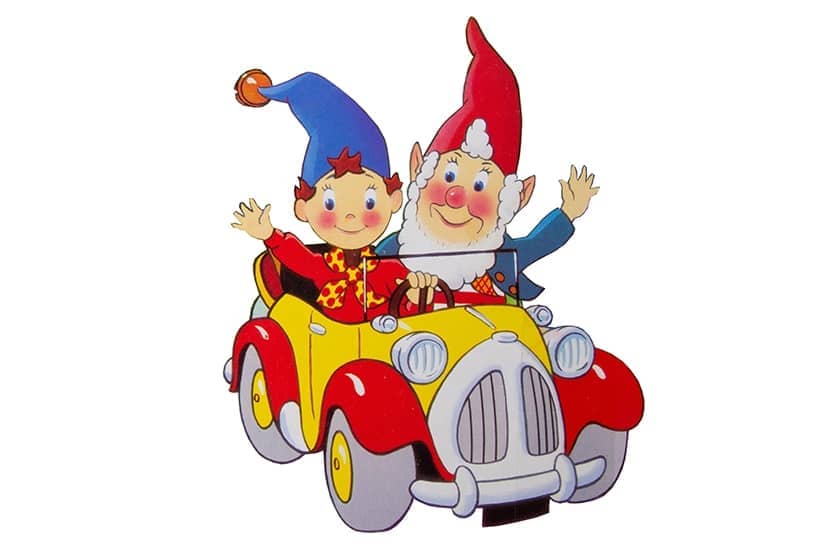Perhaps the funniest of the many funny jokes in Sue Townsend’s The Secret Diary of Adrian Mole, Aged 13¾ is its protagonist’s struggle with Enid Blyton. Having turned the corner into adolescence, Adrian is mortified by the Blyton characters on the wallpaper in his childhood bedroom and sets about repainting the room in black, the better to represent his turbulent soul. And yet, though he slaps on coat after coat of black paint, the shiny yellow bells on Noddy’s cap continue to show through. He’s reduced to colouring them in one by one. (‘Went over hat bells with black felt-tip pen, did 69 tonight, only 124 to go.’)
Adrian Mole wasn’t the only critic ever to have wanted to paint Blyton out of existence; nor the only to have been frustrated by the determination of those bells to shine through. She is and was, undeniably, a phenomenon in publishing: by 2019 she was reckoned to have sold 600 million books.
Can we call her a phenomenon in literature? Even in her heyday she was denounced for the tweeness and simplicity of her style. Colin Welch called Noddy ‘the most egocentric, joyless, snivelling and pious anti-hero in the history of British fiction’; a psychiatrist consulted for a magazine profile called him an ‘educationally subnormal nit’ and Big Ears a ‘ridiculous dwarf’. Noel Streatfeild sniffed that Blyton’s ‘very simple stories […] are meant for the less intelligent public’. The charge sheet — now that golliwogs, gender stereotyping and a generalised enthusiasm for the imperial project have gone even further out of fashion — has lengthened since then.
Even Maunder, who comes not to bury Blyton but to praise her, starts a bit on the back foot, saying in his introduction: ‘This book will also suggest that Blyton is occasionally a more complex writer than she appears.’ That qualifier ‘occasionally’ can’t help but leap out of the sentence. Later he notes with mild regret: ‘It was here that her lifetime habit of overproducing stories about elves, brownies and sprites also seems to have begun…’ As for Noddy, we’re warned that a later chapter will deal with ‘her creation of another popular but highly controversial (and, some would argue, idiotic) series, Noddy in Toyland’. ‘Some would argue.’ Poor Noddy! Poor Blyton, for that matter.
For a nation still on rationing, all those cream teas with lashings of ginger beer were potent fantasies
Like many children’s writers at whom critics are inclined to sneer, Blyton connected very directly and successfully with her readers. The simplicity of style was not a defect: it was part of the plan. She was credited, as You-Know-Who has been in our own age, with kindling an enthusiasm for reading in a whole generation of children; and, like You-Know-Who, Blyton wasn’t original, but originality was hardly the point. She magpied genres and motifs from existing children’s stories (fairies and pixies; desert-island ‘Robinsonades’; boarding school capers; circus stories, school hols adventures in the pattern of Arthur Ransome; animal stories after Black Beauty); and she adapted adult genres for children — thrillers in the Famous Five; Golden Age crime stories in the Secret Seven.
It did not hurt that the intuitive conservatism of her stories and almost complete absence from them of sex and violence tended to earn the approval of those readers’ parents. In the jargon of the modern censor, these stories contained ‘mild peril’. Here were tales of plucky, white, very middle-class children romping off for adventures in an idealised English countryside that tended to affirm the basic safeness and rightness of their world. Her name — whether it raises a damp eye of nostalgia or a sneer of deprecation — remains in our culture the byword for a particular image of England.
She caught, as Maunder describes it, two great waves in the first half of the last century. The first was the post-Victorian expansion of the market for fiction (as somewhat regretted by Q.D. Leavis in Fiction and the Reading Public). Writing guides and correspondence courses (‘Everyone Can Write’) proliferated. Anyone with an education, it seemed, could aspire to make money as a writer — and with a publishing industry desperate for material and a wide array of magazines publishing verse, short stories and serial fiction, very many did.
The young Blyton, while working as a teacher in Beckenham and then a governess in Surbiton, bought writing manuals and joined a creative writing group called the Quill Club. She submitted poems and stories to magazines. In writing at first about children and fairies and anthropomorphic animals she wasn’t just indulging a private whimsy: she had a professional’s eye on the market. It was to stay with her all her life. With her first book Child Whispers she was, as Maunder notes wryly, part of the ‘Class of 22’ that included Ulysses and The Waste Land. She never had much time for modernism herself, complaining in an early article that ‘highbrow’ culture was all ‘doleful, morbid or sad’: ‘I’m young and normal, and I prefer something more wholesome.’
The second wave she caught, in her pomp in the 1940s and 1950s, was the thirst for an imaginary escape from the postwar malaise. J.G. Ballard, who arrived in the UK from Shanghai in 1946, later recalled that it looked more like a country that had lost a war than won one. Blyton early on realised that ignoring the war rather than weaving it into her stories was the way to go. For a nation hoarding butter-wrappers and yearning for unrestricted access to sugar and fresh eggs, all those cream teas with lashings of ginger beer were potent fantasies.
What of Blyton the woman? Her public image in adulthood was one of immaculate bourgeois respectability. She played the perfect suburban housewife (golf, bridge, flower arranging, planning menus), but of course with her rate of literary production she relied on teams of servants. Maunder identifies a basic tension in the ‘dynamic, ambitious writer who wielded considerable power in a male world but who also espoused the values of home and husband’.
Biographers and film-makers have sought to make hay over the years with the idea that her cheerful stories issued from some psychological wound. Certainly, inevitably, she was more complicated than her work. Her adored father abandoned the family for another woman when she was 13 years old, and the young Blyton took against her mother — leaving home to lodge with a friend’s aunt when she was 18. When her mother died in 1950 she didn’t go to the funeral. Her first marriage, to Hugh Pollock, an eminent publisher with whom she formed both a personal and professional partnership, foundered during the second world war. She had an affair with a dull and squeaky-voiced surgeon called Kenneth Darrell Waters, persuaded Pollock to let her divorce him rather than allow her adultery to enter the public record, and married Waters in 1943. She expunged Pollock from their daughters’ lives and the marriage from her biography.
She was a conscious cultivator of her own brand. And, like disconcertingly many writers for children, she seemed more interested in the ‘family’ of children who were her readers than in her own offspring. Her daughter Imogen recalled ‘the confusing mixture of beatings and pocket money handed out by “the woman with dark curly hair and brown eyes” who worked on a typewriter downstairs’. In Imogen’s account she realised only quite belatedly that the ‘absolute ruler of our household’ was ‘also my mother’.
Maunder’s book is a deft and absorbing skip through Blyton’s life, work and reputation — neither quite a full-dress biography (there have been a few) nor a narrowly academic work, but something of a hybrid. Here are chapters on her critical reputation and public persona, on various phases of her life, on aspects of the work (the canon is so enormous he admits no short book can be comprehensive), her postwar swerve into being a public moralist (scourge of comics, socialism, bad mothers and juvenile delinquents), her 1950s excursion into live theatre, and so on. It acknowledges the questions of racism, sexism and snobbery that have dominated so much recent discussion about her, but does not obsess on them: it strives, rather, to see her in her historical context and in the round. He picks out, too, the cross-currents and complications in her world view. Here’s an engaging introduction, admirably well furnished with notes and bibliography, drily funny here and there, and not too high-minded to be gossipy.
A favourite strand, for me, is that Alison Uttley of Little Grey Rabbit fame was a Beaconsfield neighbour (like Stella Street for children’s writers, perhaps); and, being both even snootier than Blyton and less successful, hated her like sin. The tone was set when they were first brought together at lunch by well-meaning mutual friends. Uttley to Blyton: ‘I know the book you wrote about a horse, but what else have you written?’ Blyton (icicles forming on her upper slopes): ‘Smith’s window is full of my books. You can see a few titles if you care to look.’
Uttley later explained to another guest, in what we may suspect is feigned mortification: ‘You see, Katherine, I had mixed her up with Enid Bagnold and National Velvet.’







Comments